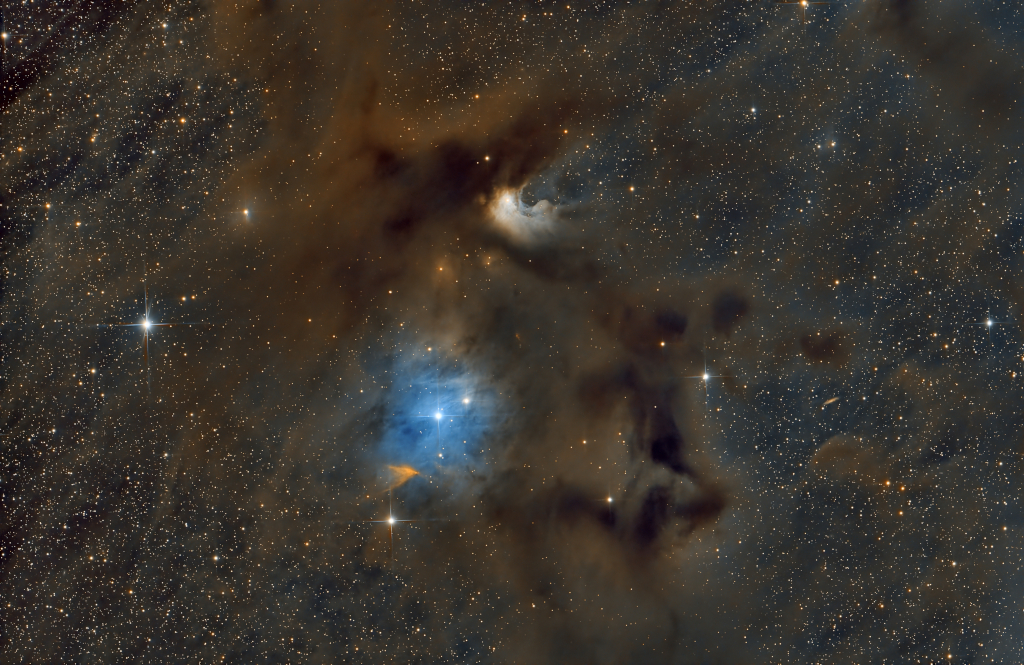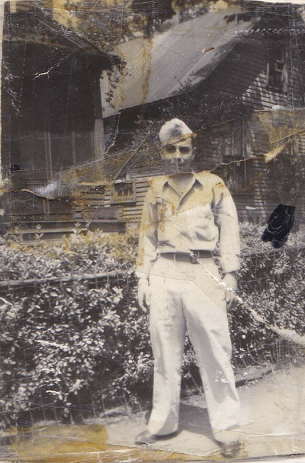Blog
Dark markings and bright nebulae in this telescopic southern sky view are telltale signs of young stars and active star formation. They lie a mere 650 light-years away, at the boundary of the local bubble and the Chamaeleon molecular cloud complex. Regions with young stars identified as dusty reflection nebulae from the 1946 Cederblad catalog include the C-shaped Ced 110 just above and right of center, and bluish Ced 111 below it. Also a standout in the frame, the orange tinted V-shape of the Chamaeleon Infrared Nebula (Cha IRN) was carved by material streaming from a newly formed low-mass star. The well-composed image spans 1.5 degrees. That’s about 17 light-years at the estimated distance of the nearby Chamaeleon I molecular cloud.

Leland Bruce Sklar (born May 28, 1947) is an American bassist and session musician. He rose to prominence as a member of James Taylor‘s backing band, which coalesced into a group in its own right, The Section, which supported so many of Asylum Records‘ artists that they became known as Asylum’s de facto house band, as those artists became iconic singer-songwriters of the 1970s.
Sklar has recorded and toured with artists including James Taylor, Jackson Browne, Carole King, Linda Ronstadt, Phil Collins, Toto, The Doors and Lyle Lovett. As a group member, session player, or touring musician, Sklar has appeared on over 2,000 albums, and contributed to many motion picture and television show soundtracks. Since 2018, he has been the bassist for The Immediate Family, a group reuniting lifelong friends and most of his former bandmates from The Section.
Leland Bruce Sklar was born May 28, 1947, in Milwaukee, Wisconsin. His mother’s family was from Duluth, Minnesota. His father’s family was from Milwaukee. Originally, the paternal side of the family came from Odesa, Ukraine. Sklar is a Ukrainian surname meaning glazier, a person whose profession is fitting glass into windows and doors.
more...John Henry Creach (May 28, 1917 – February 22, 1994), better known as Papa John Creach, was an American blues violinist who also played classical, jazz, R&B, pop and acid rock music. Early in his career, he performed as a journeyman musician with Louis Armstrong, Fats Waller, Stuff Smith, Charlie Christian, Big Joe Turner, T-Bone Walker, Nat King Cole and Roy Milton.
Following his rediscovery by drummer Joey Covington in 1967, he fronted a variety of bands (including Zulu and Midnight Sun) in addition to playing with Jefferson Airplane, Hot Tuna, Jefferson Starship, the San Francisco All-Stars (1979–1984), Dinosaurs (1982–1989) and Steve Taylor.
Creach recorded a number of solo albums and guested at several Grateful Dead and Charlie Daniels Bandconcerts. He was a regular guest at the early annual Volunteer Jams, hosted by Charlie Daniels, which exposed him to a new audience that was receptive to fiddle players.
Creach was born in Beaver Falls, Pennsylvania. As a child, he was introduced to the violin by an uncle, and he received both tutoring in the instrument and conservatory training. Creach and his family moved to Chicago in 1935.
more...Aaron Thibeaux “T-Bone” Walker (May 28, 1910 – March 16, 1975) was an American blues musician, composer, songwriter and bandleader, who was a pioneer and innovator of the jump blues, West Coast blues, and electric blues sounds. In 2018 Rolling Stone magazine ranked him number 67 on its list of “The 100 Greatest Guitarists of All Time”.
Aaron Thibeaux Walker was born in Linden, Texas, of African-American and Cherokee descent. His parents, Movelia Jimerson and Rance Walker, were both musicians. His stepfather, Marco Washington (a member of the Dallas String Band), taught him to play the guitar, ukulele, banjo, violin, mandolin, and piano.
Walker began his career as a teenager in Dallas in the 1920s. His mother and stepfather were musicians, and Blind Lemon Jefferson, a family friend, sometimes came over for dinner. Walker left school at the age of 10, and by 15, he was a professional performer on the blues circuit. Initially, he was Jefferson’s protégé and would guide him around town for his gigs. In 1929, Walker made his recording debut with Columbia Records, billed as Oak Cliff T-Bone, releasing the single “Wichita Falls Blues” backed with “Trinity River Blues”. Oak Cliff is the community in which he lived at the time, and T-Bone is a corruption of his middle name. The pianist Douglas Fernell played accompaniment on the record.
more...Andrew Dewey Kirk (May 28, 1898 – December 11, 1992) was an American jazz bandleader and saxophonist who led the Twelve Clouds of Joy, a band popular during the swing era.
He was born in Newport, Kentucky, United States. Kirk grew up in Denver, Colorado, where he was tutored by Wilberforce Whiteman, Paul Whiteman‘s father. Kirk started his musical career playing with George Morrison’s band, but then went on to join Terrence Holder‘s Dark Clouds of Joy. In 1929, he was elected leader after Holder departed. Renaming the band Clouds of Joy, Kirk also relocated the band from Dallas, Texas, to Kansas City, Missouri. Although named the Clouds of Joy, the band has also been known as the Twelve Clouds of Joy due to the number of musicians in the band. They set up in the Pla-Mor Ballroom on the junction of 32nd and Main in Kansas City and made their first recording for Brunswick Records that same year. Mary Lou Williams came in as pianist at the last moment, but she impressed Brunswick’s Dave Kapp, so she became a member of the band.
more...Honoring my dad Mike Labriola today who suffered greatly serving the USA, his new country, moving from his homeland of Italy. Traumatized and grief stricken by the experience he persevered and made it back home.

more...
This week, an image of the broad and sweeping spiral galaxy NGC 4731 is the Hubble Picture of the Week. This galaxy lies among the galaxies of the Virgo cluster, in the constellation Virgo, and is located 43 million light-years from Earth. This highly detailed image was created using six different filters. The abundance of colour illustrates the galaxy’s billowing clouds of gas, dark dust bands, bright pink star-forming regions and, most obviously, the long, glowing bar with trailing arms.
Barred spiral galaxies outnumber both regular spirals and elliptical galaxies put together, numbering around 60% of all galaxies. The visible bar structure is a result of orbits of stars and gas in the galaxy lining up, forming a dense region that individual stars move in and out of over time. This is the same process that maintains a galaxy’s spiral arms, but it is somewhat more mysterious for bars: spiral galaxies seem to form bars in their centres as they mature, accounting for the large number of bars we see today, but can also lose them later on as the accumulated mass along the bar grows unstable. The orbital patterns and the gravitational interactions within a galaxy that sustain the bar also transport matter and energy into it, fuelling star formation. Indeed, the observing programme studying NGC 4731 seeks to investigate this flow of matter in galaxies.
Beyond the bar, the spiral arms of NGC 4731 stretch out far past the confines of this close-in Hubble view. The galaxy’s elongated arms are thought to result from gravitational interactions with other, nearby galaxies in the Virgo cluster.
[Image Description: A close-in view of a barred spiral galaxy. The bright, glowing bar crosses the centre of the galaxy, with spiral arms curving away from its ends and continuing out of view. It’s surrounded by bright patches of light where stars are forming, as well as dark lines of dust. The galaxy’s clouds of gas spread out from the arms and bar, giving way to a dark background with some foreground stars and small, distant galaxies.]

Niels-Henning Ørsted Pedersen (Danish pronunciation: [ne̝lsˈhene̝ŋ ˈɶɐ̯steð ˈpʰeðɐsn̩], 27 May 1946 – 19 April 2005), also known by his abbreviated nickname NHØP, was a Danish jazz double bassist.
Pedersen was born in Osted, near Roskilde, on the Danish island of Zealand, the son of a church organist. As a child, Ørsted Pedersen played piano, but from the age of 13, he started learning to play upright bassand at the age of 14, while studying, he began his professional jazz career in Denmark with his first band, Jazzkvintet 60 (Danish for Jazz Quintet 60). By the age of fifteen, he had the ability to accompany leading musicians at nightclubs, working regularly at Copenhagen’s Jazzhus Montmartre, after his debut there on New Year’s Eve 1961, when he was only 15. When seventeen, he had already turned down an offer to join the Count Basie orchestra, mainly because he was too young to get legal permission to live and work as a musician in the United States.
The Montmartre was a regular stop-off for touring American Jazz stars, and as a member of the house band, the young Ørsted Pedersen performed with saxophonists such as Booker Ervin, Sonny Rollins, Dexter Gordon, Rahsaan Roland Kirk and Stan Getz, and pianist Bill Evans, with whom he toured in Europe in 1965. During the 1960s, Pedersen played with a series of other important American jazzmen who were touring or resident in Denmark, including Ben Webster, Brew Moore, Bud Powell, Count Basie, Roy Eldridge, Dizzy Gillespie, Jackie McLean, and vocalist Ella Fitzgerald.
more...Dee Dee Bridgewater (née Denise Garrett, May 27, 1950) is an American jazz singer and actress. She is a three-time Grammy Award-winning singer-songwriter, as well as a Tony Award-winning stage actress. For 23 years, she was the host of National Public Radio’s syndicated radio show JazzSet with Dee Dee Bridgewater. She is a United Nations Goodwill Ambassador for the Food and Agriculture Organization.
Born Denise Eileen Garrett to an African American family in Memphis, Tennessee, she was raised Catholic in Flint, Michigan. Her father, Matthew Garrett, was a jazz trumpeter and teacher at Manassas High School, and through his playing, she was exposed to jazz early on. At the age of 16, she was a member of a Rock and R&B trio, singing in clubs in Michigan. At 18, she studied at Michigan State University before she went to the University of Illinois at Urbana-Champaign. With the school’s jazz band, she toured the Soviet Union in 1969.
The next year, she met trumpeter Cecil Bridgewater, and after their marriage, they moved to New York City, where Cecil played in Horace Silver‘s band. In the early 1970s, Bridgewater joined the Thad Jones-Mel Lewis Jazz Orchestra as lead vocalist. This marked the beginning of her jazz career, and she performed with many of the great jazz musicians of the time, such as Sonny Rollins, Dizzy Gillespie, Dexter Gordon, Max Roach, Rahsaan Roland Kirk, Wayne Garfield, and others. She performed at the Monterey Jazz Festival in 1973. In 1974, her first solo album, entitled Afro Blue, appeared, and she performed on Broadway in the musical The Wiz.[5] For her role as Glinda the Good Witch she won a Tony Award in 1975 as “Best Featured Actress”, and the musical also won the 1976 Grammy Award for Best Musical Show Album.
more...Clifford Everett “Bud” Shank Jr. (May 27, 1926 – April 2, 2009) was an American alto saxophonist and flautist. He rose to prominence in the early 1950s playing lead alto and flute in Stan Kenton‘s Innovations in Modern Music Orchestra and throughout the decade worked in various small jazz combos. He spent the 1960s as a first-call studio musician in Hollywood. In the 1970s and 1980s, he performed regularly with the L. A. Four. Shank ultimately abandoned the flute to focus exclusively on playing jazz on the alto saxophone. He also recorded on tenor and baritone sax. His most famous recording is probably the version of “Harlem Nocturne” used as the theme song in Mickey Spillane’s Mike Hammer. He is also well known for the alto flute solo on the song “California Dreamin’” recorded by The Mamas & the Papas in 1965.
Bud Shank was born in Dayton, Ohio, United States. He began playing the clarinet in Vandalia, Ohio, but switched to saxophone before attending the University of North Carolina. While at UNC, Shank was initiated into the Pi Kappa Alpha fraternity. In 1946, he worked with Charlie Barnet before moving on to Kenton and the West coast jazz scene. He also had a strong interest in what might now be termed world music, playing Brazilian-influenced jazz with Laurindo Almeida in 1953 and 1954. In 1958, he became the first American jazz musician to record in Italy, with an Italian jazz orchestra conducted by Ezio Leoni (aka Len Mercer), paving the way for Chet Baker and others who would follow Shank’s tracks recording in Milan with Maestro Leoni. In 1958 and 1960, Shank provided the soundtracks for two Bruce Brown surf movies: Slippery When Wet and Barefoot Adventure. His world music collaborations continued in 1962, fusing jazz with Indian traditions in collaboration with Indian composer and sitar player Ravi Shankar.
more...Kenny Dennis (born May 27, 1930) is a Philadelphia-born American jazz drummer. He has played on albums for Nancy Wilson, Sonny Stitt, Sonny Rollins, Johnny Griffin, Oscar Brown Jr., Charles Mingus, Billy Taylor, and Mal Waldron.
Dennis began his musical career in the United States Army Band, playing drums in three bands from 1948-1952. After being discharged, he connected with junior high school mate, pianist Ray Bryant and became part of The Ray Bryant Trio along with Jimmy Rowser on bass. They became the house trio at the North Philadelphia Jazz Club, Blue Note where they played for such jazz artists as Kai Winding, Chris Connor and Sonny Stitt. His career next took him to New York, where he worked with artists including Miles Davis, Phineas Newborn, Jr., Billy Taylor, Erroll Garner, Charles Mingus and Sonny Rollins.
In 1957, Dennis performed in Sonny Rollins’s Trio with bassist Wendell Marshall at Carnegie Hall—a historic performance that was commemorated in 2007 with a 50th anniversary concert. Dennis moved to California, when Miles Davis recommended him to Lena Horne. Recording credits include recordings with such artists as Michel Legrand, Miles Davis, Charlie Mingus, Nancy Wilson, Gerald Wilson and poet Langston Hughes.
Since 1997 he has been an assistant director of the Lab Band at the award winning Los Angeles County High School for the Arts. He and his wife Nancy Wilson were married from 1960 to 1970. Their son, Kacy (né Kenneth Dennis, Jr.) was born in 1963.
more...It just threw a filament. Toward the middle of 2012, a long standing solar filament suddenly erupted into space, producing an energetic coronal mass ejection (CME). The filament had been held up for days by the Sun’s ever changing magnetic field and the timing of the eruption was unexpected. Watched closely by the Sun-orbiting Solar Dynamics Observatory, the resulting explosion shot electrons and ions into the Solar System, some of which arrived at Earth three days later and impacted Earth’s magnetosphere, causing visible auroras. Loops of plasma surrounding the active region can be seen above the erupting filament in the featured ultraviolet image. Our Sun is nearing the most active time in its 11-year cycle, creating many coronal holes that allow for the ejection of charged particles into space. As before, these charged particles can create auroras.

Stephanie Lynn Nicks (born May 26, 1948) is an American singer-songwriter known for her work with the band Fleetwood Mac and as a solo artist.
After starting her career as a duo with her then-boyfriend Lindsey Buckingham, releasing the album Buckingham Nicks to little success, Nicks joined Fleetwood Mac in 1975, helping the band to become one of the best-selling music acts of all time with over 120 million records sold worldwide. Rumours, the band’s second album with Nicks, became one of the best-selling albums worldwide, being certified 20× platinum in the US. In 1981, while remaining a member of Fleetwood Mac, Nicks began her solo career, releasing the studio album Bella Donna, which topped the Billboard 200 and has reached multiplatinum status. She has released eight studio solo albums and seven studio albums with Fleetwood Mac, selling a certified total of 65 million copies in the U.S. alone.
After the release of her first solo album, Rolling Stone named her the “Reigning Queen of Rock and Roll“.Nicks was named one of the 100 Greatest Songwriters of All Time and one of the 100 Greatest Singers of All Time by Rolling Stone. Her Fleetwood Mac songs “Landslide“, “Rhiannon“, and “Dreams“, with the last being the band’s only number one hit in the U.S., together with her solo hit “Edge of Seventeen“, have all been included in Rolling Stone‘s list of the 500 Greatest Songs of All Time. She is the only woman to have been inducted twice into the Rock and Roll Hall of Fame: first as a member of Fleetwood Mac in 1998 and then as a solo artist in 2019.
Nicks has garnered eight Grammy Award nominations and two American Music Award nominations as a solo artist. She has won numerous awards with Fleetwood Mac, including a Grammy Award for Album of the Year in 1978 for Rumours. The albums Fleetwood Mac, Rumours, and Bella Donna have been included in the “Greatest of All Time Billboard 200 Albums” chart by Billboard. Rumours was also rated the seventh-greatest album of all time in Rolling Stone‘s list of the “500 Greatest Albums of All Time“, as well as the fourth-greatest album by female acts.
more...Angela Isadora Duncan (May 26, 1877 or May 27, 1878 – September 14, 1927) was an American-born dancer and choreographer, who was a pioneer of modern contemporary dance and performed to great acclaim throughout Europe and the US. Born and raised in California, she lived and danced in Western Europe, the US and Soviet Russia from the age of 22. She died when her scarf became entangled in the wheel and axle of the car in which she was travelling in Nice, France.
Angela Isadora Duncan was born in San Francisco, the youngest of the four children of Joseph Charles Duncan (1819–1898), a banker, mining engineerand connoisseur of the arts, and Mary Isadora Gray (1849–1922). Her brothers were Augustin Duncan and Raymond Duncan; her sister, Elizabeth Duncan, was also a dancer.
more...More Posts
- James “Sugar Boy” Crawford
- Nappy Brown
- Guitar Gabriel
- Harmonica Frank
- Tubby Hall
- Jay Epstein
- World Music Abdel Karim Ensemble
- Daily Roots Stephen Marley
- Truth Battleground States
- Nyabinghi Collection
- Cosmos Ring of Fire/Easter Island
- Lester Bowie
- Billy Higgins
- Art Blakey
- Flamenco Fridays Camerón
- Daily Roots Don Carlos
- Cosmos NGC 7000
- Ed Volker
- Cyril Neville
- John Prine